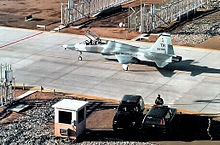4450th Tactical Group
On 17 January 1981 the Lockheed test team at Groom Lake accepted delivery of the first full Scale Development (FSD) prototype #79-780, designated YF-117A.
[1] At 6:05 a.m. on 18 June 1981, Lockheed Skunk Works test pilot Hal Farley lifted the nose of YF-117A #79-780 off the runway of Groom Lake.
Officially activated on 15 October 1979, by early 1980 a handful of officers and enlisted men recruited into the program and were told that they were laying the groundwork for a unit whose mission would be to run avionics tests and evaluations for A-7D Corsair II weapon systems.
The flinty sparkle of the stars in the desert sky seemed to accentuate the vast blackness, reminding him that night operations were always scary.
Finally cleared for takeoff, Major Whitley pushed the throttles forward and scanned the F-117's instruments for any warnings as the aircraft lumbered noisily down the runway.
Of course, this meant that the reverse actions had to occur at the end of the depot work before the aircraft could be reassembled, flight-tested, and redelivered, again under the cover of darkness.
In addition to flight-testing, Groom performed radar profiling, F-117 weapons testing, and was the location for training of the first group of frontline USAF F-117 pilots.
The 6,000 ft runway was lengthened to 10,000 ft. Taxiways, a concrete apron, a large maintenance hangar, and a propane storage tank were added.
During the operational lifetime of the F-117, personnel from Tonopah and later Holloman AFB were temporarily deployed to Groom Lake for checkout flights of classified elements of the aircraft.
Eventually a recreation center was built, with a bowling alley, gymnasium, racquetball courts, and weight room, as well as a book and video library.
Tonopah became much like any other isolated Air Force base, but it lacked dependents, and nights in the Man Camp were punctuated by the distant sound of jet aircraft taking off and landing.
[2] Group personnel worked four days per week and would be flown to Tonopah either on Monday or Tuesday morning using Key Airlines contractor-provided Boeing 727 and later 737 passenger jets from Nellis AFB.
[3] The plan called for the F-117As to fly from Tonopah TTR to Myrtle Beach AFB, South Carolina, where they would be put in hangars.
The attack was planned against positively identified locations of the terrorist groups that were known to be responsible for the car bomb and the deaths of 183 Marines of the peace keeping force in Beirut.
To maintain the deception, each A-7D was outfitted with old napalm canisters painted black with a flashing red danger light in the rear.
When the 4450th TG deployed carrying these bogus devices, Air Police closed down the base and ringed the field with machine gun-toting jeeps.
They forced all the runway personnel to turn their backs to the A-7s as they taxied past, and actually had them spread-eagled on the deck with their eyes closed until the 4450th TG A7s took off.
During this time, Libya's Colonel Muammar al-Gaddafi had been challenging the US Navy for about a year and a half and had also sponsored a number of terrorist activities in Europe.
[3] The 4450th TG's mission continued to evolve under a cloak of secrecy, as all Tonopah training flights conducted at night under the cover of darkness until late 1988.
[2] Some rather odd stories and rumors began to circulate about this incident in an attempt to explain the high amount of secrecy as well as to throw the media or the merely curious off the track.
There was a report that the recovery crew had dug and sifted the soil to a distance of 1,000 yards from the last recognizable debris and to a depth of 6 feet to make sure that no one snooping in the area would ever find any piece of the aircraft.
Another story was that to mislead scavengers, the recovery crew had taken the remains of a crashed F-101A Voodoo that had been at Groom Lake for over 20 years, broken them up, and scattered them throughout the area.
[2] In an article not long afterward, The Washington Post quoted unnamed defense sources as saying that roughly 50 stealth aircraft were operational and combat-ready, although the true figure was about half that large.
[8] 1980 was an election year and on 22 August 1980, Defense Secretary Harold Brown held a press conference: "...I am announcing today a major technological advance of great military significance.
This so-called 'stealth' technology enables the United States to build manned and unmanned aircraft that cannot be successfully intercepted with existing air defense systems.
[8] The Brown press conference set off a firestorm of charges by Republicans that the Carter Administration was using stealth technology to curry voters in the wake of the Iran Hostage Crisis and the failure of the Desert One rescue mission.
The general pattern was a long SR-71-like fuselage, elliptical wings at the rear, a bubble canopy, canards, and twin inward-canted fins.
On 22 August 1986, a story in The Washington Post said that about fifty aircraft were operational, that the F-19 designation was incorrect, and that the plane was described as "ugly" due to its bulging, nontraditional shape.
It also contained the facts that the first flight had been made in June 1981, that three had crashed, and that fifty-two had been delivered out of a total of fifty-nine ordered from Lockheed.
[3] With the 1988 public announcement of the existence of the F-117A program, the formerly clandestine 4450th Tactical Group, which had transitioned the F-117 from a development to operational weapons system was put on the road to inactivation when the Air Force decided to increase the 4450th TG to a Wing level organization.











